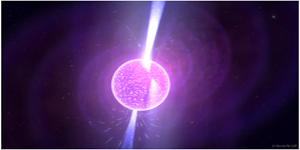The International Centre for Space and Cosmology encourages research in various areas of Astrophysics and Cosmology. Some of the areas under active investigation include:
 |
BaryogenesisThe very early Universe is expected to have equal amounts of matter and antimatter. However observations today indicate that the Universe is composed primarily of matter. Baryogenesis is a mechanism or a set of processes in the early Universe that can generate this matter-antimatter asymmetry. Members at the Centre are interested in different models of baryogenesis involving black hole evaporation, heavy Majorana neutrinos, inflaton decay, out-of-equilibrium decays of heavy particles, and baryogenesis during the electroweak phase transition. |
 |
Gravitational Collapse and Space-Time SingularityThe final fate of gravitational collapse is one of the highly debated and unsolved problems in the theory of gravity. Current research in the International Centre for Space and Cosmology includes topics such as the Cauchy problem in gravitational collapse and quantum gravity near a naked singularity. |
 |
Gravitational Lensing and ShadowsGravitational lensing and shadows are some of the most important observational phenomena in astrophysics and cosmology. Gravitational lensing is necessary for information about dark matter and baryonic matter distribution in our universe. Gravitational lensing and shadows can give us information on the causal structure of the centre of our galaxy. This is also a current research topic in the International Centre for Space and Cosmology. |
 |
Gravitational WaveFor present day observational astrophysics and cosmology, the area of gravitational waves is important. We plan to build a LIGO prototype, currently in its initial phase. |
 |
InflationInflation is a period of accelerated expansion in the very early Universe. Research interests at the Centre cover the dynamics of inflation, the generation of energy density perturbations during inflation, and the imprint of these perturbations on the observed Cosmic Microwave Background Radiation. |
 |
PulsarThe pulse rate of a pulsing neutron star changes when it gets close to a black hole and a naked singularity. Therefore, it is also a significant astrophysical phenomenon through which one can get information about the causal structure of the centre of a galaxy. We are currently researching the behaviour of neutron stars in extreme curvature regions. |
 |
Relativistic Orbits of the S-Stars Around Sgr-A*GRAVITY, SINFONI, and UCLA galactic centre groups continuously observe the stellar motion of stars around the Milky Way galaxy centre. This observation can give us essential information about the causal structure of the galactic centre and its dynamics. Astrometric observation of S-stars in the Milky Way galactic centre provides the opportunity to probe the nature of Sgr A*. |
 |
Small Scale Structure FormationUnderstanding how small scale structures of our universe evolved from the primordial density perturbations is one of the important topics in cosmology and astrophysics. We are currently conducting research on the Importance of dark matter collapse in the formation of small scale structures. |